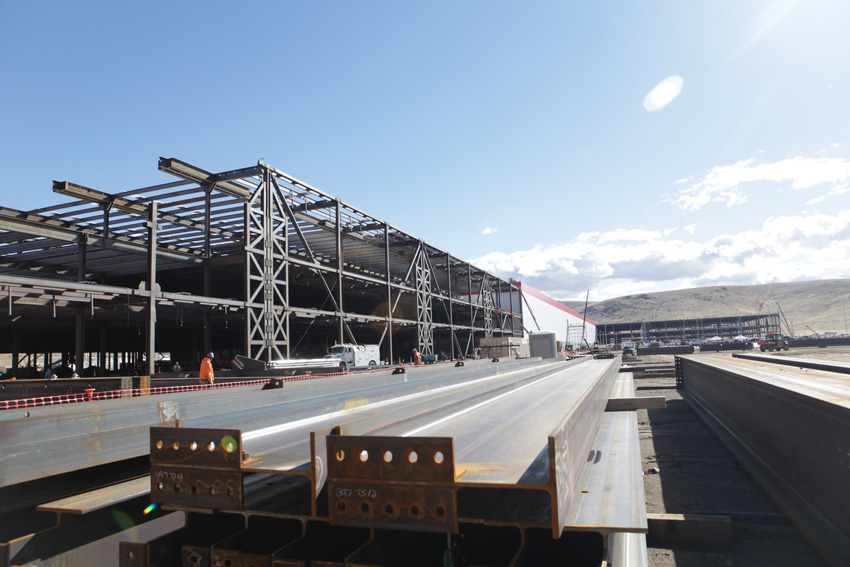Resilience: Why Material Selection Matters
Strength Predictability
The importance of material strength as a factor of resilience is not confined to the strength alone but also the predictability of that strength. Structural steel is produced as a manufactured product complying with an ASTM standard specifying a minimum strength. When it arrives on the project site it is at a predictable full strength. This is not the case with either concrete or wood. Concrete strengths are specified in the contract documents, a mix design is determined, and the material is placed in a wet state at the project site. The mix is typically designed to reach or exceed design strength 28 days after placement, which is verified by a testing service. During the 28-day period or following that period if the test specimen fails to reach the design strength, the structure under construction has a greater degree of vulnerability to the impact of extreme events. Wood is even more problematic in that the strength of a single variety of wood can vary greatly based on moisture content, growth patterns, and the alignment of the member with the grain of the wood. This unpredictability is reflected in the large number of reduction factors applied to wood strengths during design. With steel, the capacity you want is the capacity you get.Elasticity
Elasticity is the ability of a material to be deformed and return to its original shape and maintain its material properties. The greater the resistance to change, the greater is the elasticity of the material and the faster it returns to its original shape or configuration when the deforming force is removed. In other words, elasticity is measured as ratio of stress to strain. For a given stress (stretching force per unit area), strain is much smaller in steel than in wood or concrete, resulting in a higher modulus of elasticity and an enhanced capability for handling extreme loads without cracking or permanently deforming. Similarly, the ductility of a material such as structural steel allows for the redistribution of forces to provide an alternate load path or to accommodate displacements caused by extreme events.
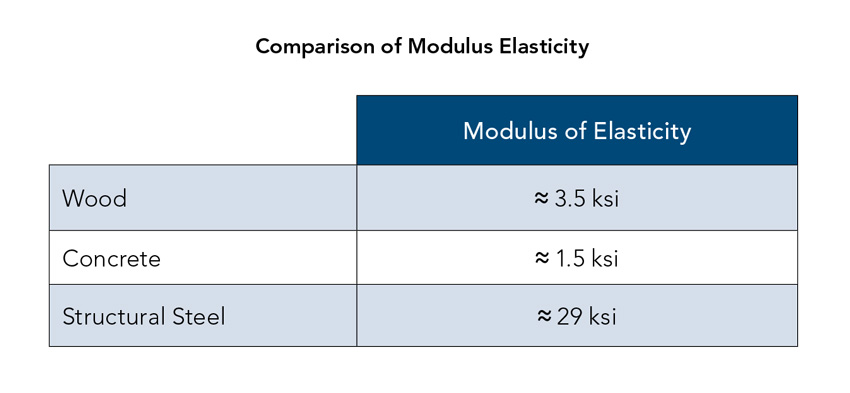
Toughness
Toughness is a measure of durability that is actually a combination of the two attributes just discussed. Toughness is the ability of the material to resist permanent deformation, fracturing, and cracking. It can be best measured as the area under the stress-strain curve. In order to be tough, a material must be both strong and ductile. For example, brittle materials (like ceramics) that are strong but with limited ductility are not tough; conversely, very ductile materials with low strengths are also not tough. To be tough, a material should withstand both high stresses and high strains. Generally speaking, strength indicates how much force the material can support, while toughness indicates how much energy a material can absorb before rupturing.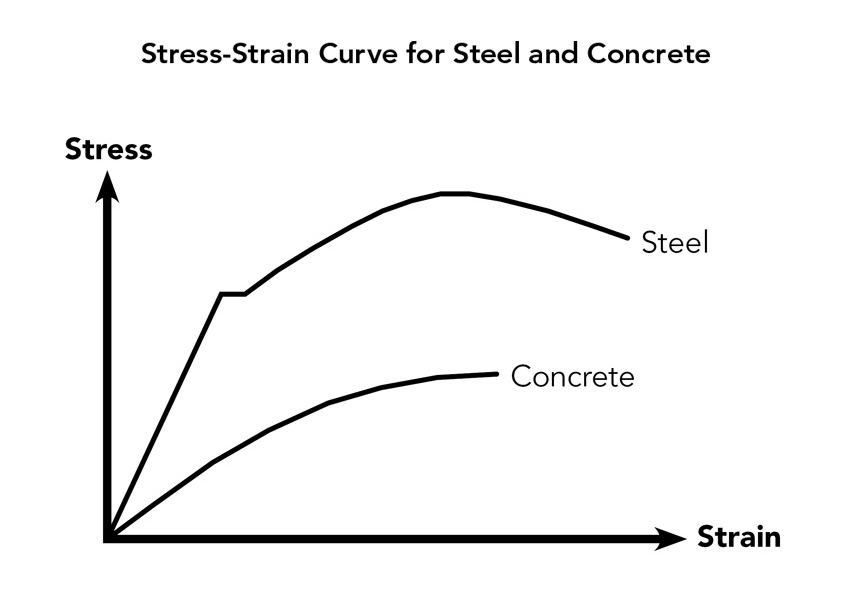
Steel is a much tougher material than concrete. Wood toughness varies greatly by species, water content, and the alignment of the grain, but even the toughest of wood does not achieve the same level of toughness as structural steel.
Combustibility
Combustibility refers to a material’s ability to burn. Materials that are combustible will burn; materials that are noncombustible will not burn. Structural steel and concrete are classified by the International Building Code as noncombustible materials. Wood is classified as a combustible material because it can burn. Under extreme fire loads, concrete is subject to spalling, exposing the steel reinforcement while structural steel’s load-carrying capability will be reduced. To overcome the loss of load-carrying capability, an insulating covering may be placed around the structural steel to slow the loss of strength, allowing occupant departure and providing time for the fire to be extinguished. As the heat abates, the structural steel will return to its full strength, allowing the effects of the fire to be mitigated and the building returned to service. This is not the case with wood. Wood burns. And even if it is argued that wood simply chars, the cross-sectional area of the section is reduced, minimizing protection in the event of a second fire and reducing the cross-sectional area available to carry the structural load.
An unfortunate casualty of wood’s combustibility was the Da Vinci apartment building in Los Angeles. In December 2014, the wood-framed apartment building still under construction burned to the ground. After the massive blaze that consumed the building, the only feature that remained intact were the noncombustible steel-framed stairs.
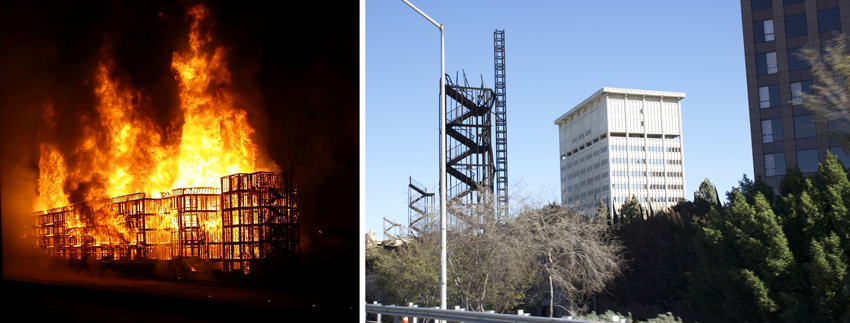
In December 2014, the Da Vinci Apartments that were under construction in Los Angeles burned down. After the massive blaze, only the steel-framed stairs remained.
When a building built from wood burns, the building burns. When a building built from steel or concrete burns, the structure remains intact while the contents of the building burn.
Resistance to Decomposition
All materials are at risk of decomposition over time. Environmental factors such as humidity, moisture and air intrusion, mold, and mildew can cause a structure to deteriorate. When selecting a material, it is important to consider its resistance to decomposition in the climate zone where the construction will occur.
Steel and concrete, unlike wood, are inorganic and won’t provide a source for mold, mildew, or structural deterioration (rot) to propagate. In wood structures, rot can compromise the structural integrity of the building, while mold and mildew compromise the health of the occupants.
One of structural steel’s major advantages when compared to other materials is that steel will not absorb water in a flood situation or provide a moisture reservoir after the event. This is in contrast to concrete, where all surfaces contain micro-cracks that can serve as paths for water to migrate to the reinforcing steel inside the concrete, resulting in corrosion of the steel and spalling of the concrete. Structural steel is not immune to the impacts of water inundation, as corrosion on the surface of the steel may occur over time. This can be prevented from occurring in locations where the structural steel may be exposed to flooding or other possible corrosive factors, as paint or galvanized coatings can be applied that will provide protection. These coatings will provide protection for an extended period, which will often exceed the anticipated service life of the structural steel. Corrosion detected on structural steel members during regular maintenance inspections is a surface condition that does not compromise the strength of the member. This corrosion can be addressed by cleaning the steel and applying a protective coating such as paint to the affected area.
For a wood structure, decomposition can also be caused by pest infestation. Termite damage to buildings in the United States results in more than $5 billion annually. Structural steel and concrete are not subject to termite and pest damage.
While not actual physical properties, two additional factors contribute to the resilience of any particular material.
Design Redundancy
Unlike mix-dependent concrete or the variability of wood, structural steel provides additional redundancy and performs in a consistent and predictable manner as part of a structural system. Redundant load paths due to steel’s natural ductility and reserve strength capacity provide additional structural capacity and resistance. In the design process, shapes are selected from a defined list, and if load requirements fall in between two shapes, the larger section is selected providing additional strength beyond the basic design requirement. The design strength of the steel (Fy and Fu) is not the actual strength of the steel. The average actual strength of steel, which is greater than the design strength, can be estimated using the Ry and Rt multipliers found in the AISC Seismic Provisions. While these values should not be used in routine design, they can be used to evaluate the resilience of the structure. Additional strength is also gained when beams are selected based on serviceability considerations of deflection criteria, floor vibration, or drift.
Rapidity of Repair
To fully appreciate the required resiliency of a building is not only to assess the level of damage and the cost of repairs but also the amount of time required to return the building to functionality. The required time to return to functionality is a function of the criticality of the services provided in the building and should be taken into account in the initial design of the building. The return of a building to functionality may require the repair of the structural system, the replacement of structural components, and the temporary removal of portions of the structural frame to gain access to other building service components that may need to be repaired or replaced. Unlike concrete framing systems that would typically require demolition and replacement or wood systems that face the challenge of replacing numerous structural members after a flood or fire, structural steel can be strengthened in place through the use of doublers and stiffeners, structural members can be added, and beams can be penetrated to allow the addition of other services. And this can be done using materials that are readily available through a network of local steel service centers and fabricators.
After the Extreme Event
Extreme events that impact an entire community rather than just a single building generate significant amounts of waste. The majority of this waste is wood. Wood waste will be either burned or landfilled. While some wood waste is reused in the normal construction cycle, it is most likely that the wood waste resulting from an extreme event will not be suitable for reuse. Burning or landfilling wood releases greenhouse gases into the atmosphere. Burning also generates particulate matter harmful to human health. Landfilling requires sufficient landfill volume to be available to handle the increase flow of waste. While concrete may be crushed and down-cycled for use as road base, a significant portion is also landfilled. Structural steel on the other hand is a fully recyclable material with an active market for its sale. It will not end up in landfills but be returned to steel mills for recycling into new steel products. It will not be a burden on the community as it seeks to rebuild.
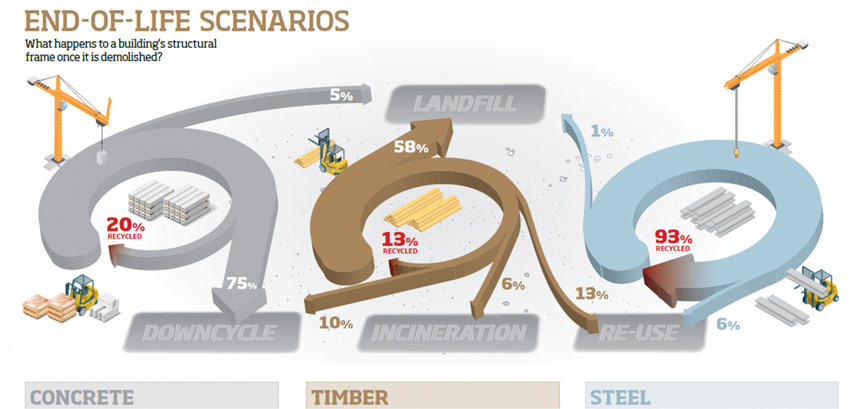
Graphic courtesy of BCSA
End-of-life scenarios for various building materials
When structures have to be renovated, remodeled, or rebuilt after a devastating event, utilizing a material that can be reused or recycled is beneficial from cost, convenience, and sustainability standpoints. Materials such as structural steel that can be quickly retrofitted, replaced, and eventually recycled make a positive impact on the environment and community. One-hundred percent of deconstructed steel structures can be recovered and recycled for the production of new steel. Currently, domestically produced structural steel has an average recycled content of 93 percent and a recovery rate of 98 percent.
Conclusion
When considering building and community resilience, it is important to evaluate the contribution of framing materials to the overall resilience of the structure and its role in the community in terms of life safety, continuity of service, speed of recovery, and the cost of recovery. Structural steel is consistently the best choice for constructing resilient buildings that help support a community. Actuarially based insurance rates for steel compared to wood and concrete confirm the superiority of steel, as structural steel buildings are consistently less costly to insure due to the reduced risk of major damage, the cost of repair, and their ability to swiftly recover after an adverse event. In addition to insurance rate metrics, structural steel and structural framing systems consistently rank highly in each category of the four Rs: robustness, resourcefulness, recovery, and redundancy. Structural steel is a strong, durable material that allows the building to rapidly and economically return to service after an adverse event. The design and construction of resilient buildings requires a wise choice of framing material—structural steel is that stronger, smarter material.
Resources
Architectural Graphic Standards, Twelfth Edition. American Institute of Architects. John Wiley & Sons. 2016.
Cross, John. The Impact of Material Selection on the Resilience of Buildings. American Institute of Steel Construction (AISC). April 2017. Web. 20 June 2018.
Ettouney, Mohammed M. “Resilience Management: How It Is Becoming Essential to Civil Infrastructure Recovery.” McGraw Hill Financial Global Institute. 15 July 2014.
Blast-Resistant Benefits of Seismic Design: Phase 2 Study: Performance Analysis of Structural Steel Strengthening Systems. Federal Emergency Management Agency (FEMA). FEMA P-439B. November 2010. Web. 20 June 2018.
Structural Steel Market Assessment. FMI Management Consultants. January 2012. (Not published.)
Lewry, A.J., and Crewdson, L.F.E. “Approaches to testing the durability of materials used in the construction and maintenance of buildings.” Construction and Building Materials. December 1994.
Mahmaoud, Hussam, and McManus, Patrick. Road to Recovery. Modern Steel Construction. American Institute of Steel Construction (AISC). April 2018. Web. 20 June 2018.
Simpson, Barbara. Sturdy Spine. Modern Steel Construction, American Institute of Steel Construction (AISC). April 2018. Web. 20 June 2018.

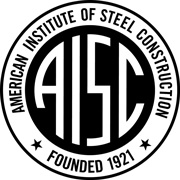
|
AISC is the leading advocate and trusted resource for American structural steel. Grounded in unsurpassed science, quality, and craftsmanship, our vibrant industry is ever-advancing and ever-improving. That’s why for nearly 100 years, AISC has proudly innovated with breakthrough research and applied technology for fabricators, engineers, architects, and the construction industry. We set the standard so you can focus on delivering visionary projects of the highest quality for your clients. As we move into our next 100 years, we’ll continue to advocate for, champion, and strengthen this vital industry. www.aisc.org |




